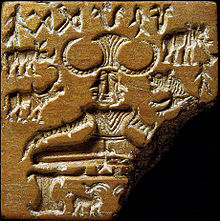-
Notifications
You must be signed in to change notification settings - Fork 12
History of Yoga
Kim Schlesinger edited this page Jan 31, 2018
·
4 revisions
from the 2018 Ghosh Yoga Immersive
- As of 2018, the oldest discovered reference to yoga is the Pashupati Seal from 2,500 BCE. It shows a figure in a seated position.
 Notes:
Notes:
- Classical Yoga: 2,500 BCE-1000 CE
- Hatha Yoga: 1000 CE - 1858 CE
- Modern Yoga: 1858 BE - present
- When the British colonized India, European and Indian ideas began to mix. This was the beginning of the modern era of hatha yoga.
- Most of what we know about yoga is from the last 150 years.
- There are many yoga texts and many yoga systems
- Veda means knowledge or wisdom
- The Vedas are the oldest Hindu texts (1700-1100 BCE)
- The texts are 'revealed' like terma, and have no author
- These are the foundational texts of Hinduism.
- There are 4 collections of Vedas:
- Rig-Veda
- Sama-Veda
- Yajur-Veda
- Atharva-Veda
- Each collection has 4 chapters or text-types:
- Samhita
- Aranyakas
- Brahmanas
- Upanishads
- The last text in each veda
- Foundation of Vedanta
- The origin of the concepts Brahman with Atman
The Vedas are the root text
- Samkhya
- Yoga
- Nyaya
- Vaisheshika
- Purva Mimamsa
- Vedanta
Have root texts other than the Vedas
- Buddhism
- Jainism
- Upanishads, Bhagavad Gita, Brahma Sutras
- Main belief: 'all is one'
-
Originates from 1500 BCE
-
Oldest of the orthodox schools of Hinduism
-
The philosophy is based on rational examination
-
Core belief: the universe exists because of 2 realities:
- spirit/conciousness (purusha)
- matter/energy/creative agency (prakriti)
- 2000 years old; written ~400 CE
- 4 chapters/books
- 194 sutras
- 8 limbs or parts
- Many smaller systems within the text
- This text is why yoga is considered Hindu
- Patanjali is depicted as half human and half certain, which probably means that multiple people make up Patanjali.
